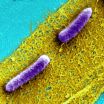(Press-News.org) This news release is available in Spanish and Spanish.
As far as the conclusions of the study are concerned, the following aspects, among others, are worth highlighting: the more compact the town or city is, the more concentrated is its population; the more jobs there are in the municipality itself, etc., the less private vehicles are used; the better the offer of public transport, the lower the number of people who use private cars; the higher the per capita income is (in small localities), the greater is the tendency to use the private car. According to Mendiola, despite the significance of these data, what has to be emphasised is "that this mobility model is not sustainable. This model depends, to a certain extent, on the characteristics of the city, so if the former are controlled, the mobility model can also be transformed".
Bizkaia underwent a radical transformation between the 1970s and the 1990s: coinciding with the industrial crisis, the hub of the economy shifted from the industrial sector to the services sector. This transformation triggered others; for example, the phenomenon known as "counter-urbanisation", in other words, the migration of many citizens and jobs from industrial towns and cities to small localities, and the resulting creation in the latter of low-density, residential areas. The following illustrates this phenomenon: at the end of the 1980s the rural area of Bizkaia lost 4.6% of its population; at the end of the 1990s, however, it saw an increase of 7%. Most of those who moved from the city to smaller towns and villages were socioeconomically on a medium-to-high level, and many of them continued to work in the capital. So they became commuters.
In their study "The Link between Urban Development and the Modal Split in Commuting: the Case of Biscay", the university lecturers Lorea Mendiola, Pilar González and Ángel Cebollada quantified the consequences this demographic growth had for mobility. According to Lorea Mendiola (co-author of the research), "the study has made it very clear that the characteristics of the town or city influence the mobility model".
The conclusions of the study are, among other things and briefly, as follows: in the period analysed (the year 2001), motor vehicle use increased because the distance between the place of residence and work also increased. As the offer of public transport is more limited in rural areas, this mobility need was largely met by the private vehicle. In 2001, in Bizkaia as a whole, 52.5% of the commuting was done in private vehicles; in the small localities (with less than 2,000 inhabitants), the percentage rose to 82%. According to Mendiola, "the characteristics of the town or city largely determine the mobility need. If these characteristics are controlled, the mobility model can also be controlled".
The socioeconomic characteristics of the user (relating to his/her way of life and habits) also influence the choice of transport to get to work. This is why, the researcher pointed out, apart from the planning policies to control city expansion, awareness campaigns and measures to discourage the (unsustainable) use of the private vehicle are also indispensable.
Multiple Regression
For this study, data from the population and housing census for 2001 were used and, even though its authors are keen to pursue the study further, "we have come up against difficulties because in 2011 the system for drawing up the census was changed," pointed out Mendiola. Furthermore, apart from commuting, the authors of the study also want to analyse the trips made by students.
As regards the system used to produce the study, "we resorted to an econometric procedure known as 'multiple regression'. What does this regression consist of? Well, it involves expressing a dependent variable through a set of independent variables using mathematical models for this purpose," explained Lorea Mendiola. Three types of variables have been used to produce this work: those relating to land use, the characteristics of the transport system and those relating to the socio-economic characteristics of the travellers. "More than anything, we have used the models proposed by spatial econometrics," pointed out Mendiola, "and that has in fact been one of the most innovative aspects of this work. What is spatial econometrics? It is a methodology that takes into account the fact that what happens on a specific geographical point is related to what occurs around it. In this case, this methodology shows us that the transport model of a locality is linked to that of the adjacent towns and villages and that the solutions need to be sought among them all."
The Research Team
The research team comprised Lorea Mendiola (UPV/EHU-University of the Basque Country), Ángel Cebollada (UAB-Autonomous University of Barcelona) and Pilar González (UPV/EHU). The study consisted of an empirical analysis of the link between the use of urban land and the mobility model using, for this purpose, data on the municipalities of Bizkaia from 1991 to 2001. The methodology used: multiple regression, and spatial econometrics techniques, in particular. The study classified the commuters into three groups: those who go to work in private vehicles, those who use public transport, and those who walk or cycle to work. So these were the dependent variables of the regressive analysis.
INFORMATION:
Bibliographical Reference
(Mendiola, L., González, P. & A. Cebollada (2014). The Link between Urban Development and the Modal Split in Commuting: the Case of Biscay. Journal of Transport Geography, 37, pp. 1-9)
The mobility model is closely linked to the city's characteristics
According to a study by the UPV/EHU-University of the Basque Country, to achieve a sustainable model, not only does the offer of public transport need to be improved, citizen demand for mobility also needs to be managed
2014-09-17
ELSE PRESS RELEASES FROM THIS DATE:
Magnetic resonance helps to detect and quantify fat in liver
2014-09-17
This news release is available in Spanish.
Obesity and overweight affect more than half of the population in our Community. Excess weight causes important alterations in the organism, one of which affects liver function. Fat accumulates in the liver producing hepatic steatosis which, in certain circumstances, causes inflammation, fibrosis and finally, cirrhosis. To date, the most reliable method for determining hepatic fat has been hepatic biopsy. Imaging techniques such as abdominal ecography detect it but are less precise for determining the quantity of fat.
But ...
Car hacking: The security threat facing our vehicles
2014-09-17
The car of the future will be safer, smarter and offer greater high-tech gadgets, but be warned without improved security the risk of car hacking is real, according to a QUT road safety expert.
Professor Andry Rakotonirainy will speak at the Occupational Safety in Transport Conference (OSIT) on the Gold Coast on September 18-19 on the security threat facing drivers as vehicles become computers on wheels.
Professor Rakotonirainy, from QUT's Centre for Accident Research & Road Safety - Queensland (CARRS), has researched the security systems of existing fleet, future ...
Survey finds benefits, risks of yoga for bipolar disorder
2014-09-17
PROVIDENCE, R.I. [Brown University] — Right now no one can say whether yoga provides clinical benefits to people with bipolar disorder, but in a new article in the Journal of Psychiatric Practice, researchers report survey responses they gathered from scores of people with the condition who practice yoga. What the collective testimony suggests is that yoga can be a substantial help, but it sometimes carries risks, too.
"There is no scientific literature on hatha yoga for bipolar disorder," said lead author Lisa Uebelacker, associate professor (research) of psychiatry ...
Cape Cod saltmarsh recovery looks good, falls short
2014-09-17
PROVIDENCE, R.I. [Brown University] — After decades of decline, grasses have returned to some once-denuded patches of Cape Cod's saltmarshes. To the eye, the marsh in those places seems healthy again, but a new study makes clear that a key service of the marsh – coastal protection – remains diminished.
"We've got the aesthetics back but the ecosystem function hasn't come back," said ecologist Mark Bertness, professor of biology at Brown and senior author of the study in the journal Biological Conservation. "The metric of a recovered habitat should not be 'Does it look ...
Recruiting bacteria to be technology innovation partners
2014-09-17
For most people biofilms conjure up images of slippery stones in a streambed and dirty drains. While there are plenty of "bad" biofilms around – they even cause pesky dental plaque and a host of other more serious medical problems – a team at the Wyss Institute for Biologically Inspired Engineering at Harvard University sees biofilms as a robust new platform for designer nanomaterials that could clean up polluted rivers, manufacture pharmaceutical products, fabricate new textiles, and more.
In short, they want to give biofilms a facelift, and have developed a novel protein ...
Phthalates heighten risk for childhood asthma
2014-09-17
Researchers at the Columbia Center for Children's Environmental Health at the Mailman School of Public Health are the first to demonstrate an association between childhood asthma and prenatal exposure to two phthalates used in a diverse array of household products. Results appear online in the journal Environmental Health Perspectives.
Children born to mothers exposed during pregnancy to higher levels of the chemicals, butylbenzyl phthalate (BBzP) and di-n-butyl phthalate (DnBP) had a 72 percent and 78 percent increase in risk of developing asthma between age 5 and 11, ...
New study examines the impact of socioeconomic position & maternal morbidity in Australia
2014-09-17
The risk of severe maternal morbidity amongst women in Australia is increased by lower socioeconomic position, suggests a new study published today (17 September) in BJOG: An International Journal of Obstetrics and Gynaecology.
Australians generally enjoy high standards of living; however, existing research has concluded that health disparities exist, in particular between indigenous and non indigenous Australians.
This case-control study aimed to explore the independent impact of socioeconomic position on severe maternal morbidities associated with direct maternal ...
A greater focus on socially disadvantaged women is needed to improve maternity care in England
2014-09-17
Women from lower socioeconomic groups in the UK report a poorer experience of care during pregnancy and there needs to be a greater focus on their care, suggests a new study published today (17 September) in BJOG: An International Journal of Obstetrics and Gynaecology (BJOG).
Differences in health outcomes amongst different socioeconomic groups have been demonstrated in many areas and have provided the focus for national initiatives in the UK to reduce the observed inequalities.
The Oxford University study, funded by the National Institute for Health Research, explores ...
NAMS issues first comprehensive recommendations on care of women at menopause and beyond
2014-09-17
CLEVELAND, Ohio (September 17, 2014)—The North American Menopause Society (NAMS) has published its key, evidence-based recommendations for the comprehensive care of midlife women—on everything from hot flashes to heart disease. The special feature, "The North American Menopause Society Recommendations for Clinical Care of Midlife Women," was published online today in the Society's journal Menopause. This is the first, comprehensive set of evidence-based recommendations for the care of midlife women freely available to all clinicians who care for women at this stage of life. ...
Sharks' skin has teeth in the fight against hospital superbugs
2014-09-17
Transmission of bacterial infections, including MRSA and MSSA could be curbed by coating hospital surfaces with microscopic bumps that mimic the scaly surface of shark skin, according to research published in the open access journal Antimicrobial Resistance and Infection Control.
The study modelled how well different materials prevented the spread of human disease bacteria through touching, sneezes or spillages. The micropattern, named Sharklet™, is an arrangement of ridges formulated to resemble shark skin. The study showed that Sharklet harboured 94% less MRSA bacteria ...
LAST 30 PRESS RELEASES:
COVID-19 leaves a lasting mark on the human brain
Scientists use ultrasound to soften and treat cancer tumors without damaging healthy tissue
Community swimming program for Black youth boosts skills, sense of belonging, study finds
Specific depressive symptoms in midlife linked to increased dementia risk
An ‘illuminating’ design sheds light on cholesterol
Who is more likely to get long COVID?
Study showcases resilience and rapid growth of “living rocks”
Naval Research Lab diver earns Office of Naval Research 2025 Sailor of the Year
New Mayo-led study establishes practical definition for rapidly progressive dementia
Fossil fuel industry’s “climate false solutions” reinforce its power and aggravate environmental injustice
Researchers reveal bias in a widely used measure of algorithm performance
Alcohol causes cancer. A study from IOCB Prague confirms damage to DNA and shows how cells defend against it
Hidden viruses in wastewater treatment may shape public health risks, study finds
Unlock the power of nature: how biomass can transform climate mitigation
Biochar reshapes hidden soil microbes that capture carbon dioxide in farmland
Reducing saturated fat intake shows mortality benefit, but only in high-risk individuals
Manta rays create mobile ecosystems, study finds
Study: Mixed results in using lipoic acid to treat progressive multiple sclerosis
Norbert Holtkamp appointed director of Fermi National Accelerator Laboratory
New agentic AI platform accelerates advanced optics design
Biologists discover neurons use physical signals — not electricity — to stabilize communication
Researchers discover that a hormone can access the brain by hitchhiking
University of Oklahoma researcher awarded funding to pursue AI-powered material design
Exploring how the visual system recovers following injury
Support for parents with infants at pediatric check-ups leads to better reading and math skills in elementary school
Kids’ behavioral health is a growing share of family health costs
Day & night: Cancer disrupts the brain’s natural rhythm
COVID-19 vaccination significantly reduces risk to pregnant women and baby
The role of vaccination in maternal and perinatal outcomes associated with COVID-19 in pregnancy
Mayo Clinic smartwatch system helps parents shorten and defuse children's severe tantrums early
[Press-News.org] The mobility model is closely linked to the city's characteristicsAccording to a study by the UPV/EHU-University of the Basque Country, to achieve a sustainable model, not only does the offer of public transport need to be improved, citizen demand for mobility also needs to be managed




